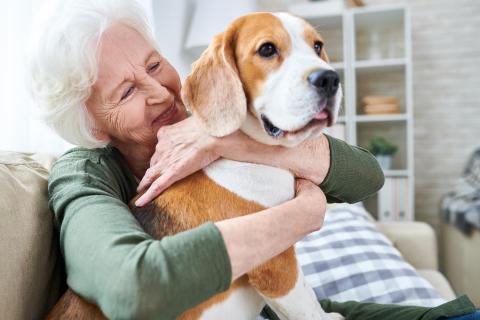Pet Safety for Older Adults
Other studies have shown that spending time with animals lessens depression, encourages socialization, provides a great context for physical activity, reduces the need for pain medication, even lowers blood pressure and cholesterol. Therapy animals bring joy and peace to people who are dealing with illness or nearing the end of life, and University of Saskatchewan professor Dr. Colleen Dell recently reported that therapy dogs lessen pain for people in the emergency room.
But with all these benefits of pet ownership, older adults should consider a few pet-related health and safety cautions:
Avoid pet-borne infections. The Centers for Disease Control and Prevention (CDC) reminds us that animals can sometimes carry harmful germs which can spread to people, causing illnesses known as zoonotic diseases. Lower the risk by washing hands after contact with a pet, and wear protective gloves while cleaning the litter box, bird cage, or fish and turtle aquariums. Animals should be under regular veterinary care.
When preparing for emergencies, don’t forget your pets. The Federal Emergency Management Agency (FEMA) reports that older adults are more vulnerable during hurricanes, floods, earthquakes, tornadoes and other natural disasters—yet after almost every natural disaster, rescue personnel report that some senior survivors refused to evacuate because they didn’t want to leave beloved pets behind. FEMA reminds pet owners to microchip pets, keep a three-day supply of non-perishable pet food on hand, and identify in advance an emergency shelter in the area that accepts pet evacuees.
Avoid pet-related falls. Though pet ownership has been found to reduce the risk of falls by keeping seniors more active and upbeat, the CDC also warns that 87,000 people each year go to the emergency room for a fall injury caused by a pet. Move pet toys and dishes out of the way. And if you own a too-rambunctious dog, it’s time for obedience school.
Leash pets in the car while driving—or leave them at home. Most of us know about the dangers of distracted driving. We pull over to make a phone call or send a text, and in most states, we face a traffic ticket if we get caught not doing so. But driving with a pet can also be hazardous. Experts from Volvo Cars USA say, “While pets roaming around the car can be cute and convenient, it poses serious risk for both drivers and their pets, both in terms of causing distractions and increasing the chances of serious injury in the event of an accident.”
Taking these precautions helps ensure that both you and your pets will continue a mutually safe and healthy companionship.
